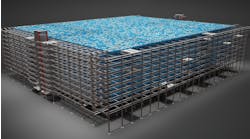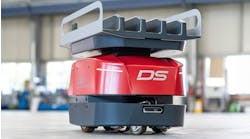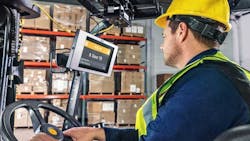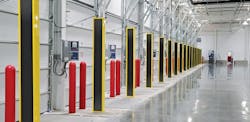Smaller Manufacturers That Want to Increase Output Should Upgrade Equipment Off the Line, Too
For most manufacturers, the best way to increase revenue is to increase output. The more products coming off the line and getting out the door, the more money that will come in.
Some argue that the most logical way to increase capacity is to add, expand or upgrade production and packaging lines. However, smaller manufacturers may not have the space to physically grow operations or the capital to rip and replace older industrial equipment right now, and that’s okay.
There are other ways to immediately boost output, and most of them only require small equipment installations or upgrades on the shop floor.
Picking Up the Pace to Close the Labor Gap
If you want to improve inventory levels and fulfill more orders tomorrow, you must first identify what’s slowing things down today.
Is it taking forklift operators twice as long as you think it should to retrieve and deliver raw materials to the line? Are new team members struggling to understand assembly diagrams or follow paper-based instructions? Are inspectors missing quality issues or questioning the accuracy of what their eyes are seeing? What about the packing team? Does it have to correct mispicks when verifying packed items against order sheets?
Maybe you’ll find everything is running smoothly until the pallets and packages are brought to the loading dock, where they subsequently sit for a day or two due to loading team labor shortages or miscommunications with shippers. Then again, maybe the delays start at the loading dock, but with incoming parts and materials stuck just inside the dock door, waiting to be inventoried and put away.
That’s why smaller manufacturers are prioritizing “equipment” investments in the information technology category. They’re trying to ensure labor isn’t the limiting factor.
Real-world deployments have proven that the labor efficiencies gained by digitizing data and digitalizing workflows can close the gap between current and desired production capacity—sometimes completely.
By installing rugged tablets in forklifts and assembly line workstations or handing them to loading dock crews and quality control inspectors, manufacturers are helping to speed up worker actions and enabling better decision-making. By giving pickers, packers, and other workers who may walk “miles of aisles” each day hand-held mobile computers and wearables, manufacturers are also helping to minimize the steps and time it takes to get each task complete and improve employee satisfaction.
They know exactly where to go, the best route to take to get there, what to do next and how to complete the task correctly. These devices, and the apps loaded onto them, can visually and verbally guide them step-by-step through their shifts. If they need clarification on an assignment or must coordinate actions with others, they can simply use the push-to-talk (PTT), messaging or app communications tools on the devices to reach colleagues.
This type of technology automatically—and safely—speeds up workflows and helps make up for the labor gaps we see on paper, as workers can take on higher-value tasks throughout the day without necessarily working harder or exerting more energy.
In fact, it’s the ease of task completion that enables you to increase output without additional headcount, as there is no time wasted trying to figure out new tasks or correct mistakes.
Learn more about Zebra's MotionWorks Warehouse solution here.
Some in the supply chain are even taking it a step further and rolling out autonomous mobile robots (AMRs) that can essentially do all the “walking” and collaborate with workers. Many smaller manufacturers find the “robot-as-a-service” (RaaS) model makes robotics automation affordable and accessible.
Within hours, they can have robots unboxed and moving materials throughout warehouses and factories. Productivity reports will instantly start flowing into the cloud for real-time monitoring.
But you should know, these aren’t the robots you might be used to seeing in manufacturing environments—even though I suspect you will be seeing a lot more of them moving forward.
The throughput rates of today’s AMRs are remarkable, especially when used for just-in-time material delivery to production lines in lean manufacturing environments.
The person who would normally manage material deliveries could be reassigned to a job that a robot can’t do—which could very well be a job that would otherwise be “open” due to labor shortages.
Doubling Down to Eliminate Uncertainty
The same technologies used to speed up workflows can also help manufacturers automate decision-making and the flow of information to suppliers, distributors, and customer decision-makers.
Many rugged, enterprise mobile devices being deployed in manufacturing environments are now equipped with built-in barcode scanners or accessorized with radio frequency identification (RFID) sleds to make it easy to confirm that the right items are being picked, packed or put away.
An instant RFID tag read or barcode scan can collect item data, verify pick, pack or put away accuracy, and update item status to the production tracking system, warehouse management system (WMS), or transportation management system (TMS).
Workers can be confident they’re taking the right action with each item, while inventory managers, operations managers, and customers can see all updates in real time.
This level of transparency isn’t sacrificed with AMRs, either. They are constantly transmitting progress reports to the cloud, making it easy to confirm each item’s current or last-known location—which, in manufacturing, might have been a raw materials delivery to the line.
The inventory tracking and utilization data provided in all scenarios build confidence in sourcing, inventory management, and even sales commitments. If raw materials are running low in the warehouse, they can be replenished before they are completely depleted. And if certain finished product SKUs may have longer lead times due to materials shortages, that can be communicated to distributors and customers to manage expectations.
Depending on how manufacturers’ systems are set up, it’s possible that detailed information about product materials, origin, production dates, current location, and expected delivery times can be made accessible to interested parties online in real-time or near-real-time.
This helps build trust in a manufacturer’s commitment to quality and capability to deliver on time. It also helps with supply chain planning and customer communications further downstream.
Fulfilling More Than Customer Orders
Manufacturers of all sizes are held to the same quality and regulatory standards, in addition to complying with distributor and customer mandates for labeling, billing, and more. This can be a challenge when manufacturers are trying to scale operations with a lean team.
However, the right technology investments both on and off the line can help automate quality and compliance verifications as order volumes increase and the pressure to shrink fulfillment lead times starts to grow.
Of course, monitoring and reporting on-hand inventory is important when perishables are involved. But being able to also document the status of packed or palletized items is important.
With RFID sleds attached to their mobile computers, loading and unloading crews can confirm the quantities and descriptions of all palletized items in a few seconds. This helps to expedite and improve the accuracy of billing and payments. It also builds confidence in a manufacturer’s ability to deliver the right goods each time—which we know downstream supply chain partners and customers value tremendously.
Better Outcomes Start with Better Communications
Though there is a lot that manufacturers can’t control right now, it is possible to control communications to workers, suppliers, distributors, and customers. The more information you can share with everyone, the more likely they are to be successful in their jobs and happy with you.
With the right technologies in their hands, in their line of sight or by their sides, your workers can easily move through tasks and reduce completion times. As their productivity rates rise, so will morale and job satisfaction. And the more information they capture and report about their progress throughout the day, the easier it becomes for inventory managers, supply chain planners, distributors, and even customers to manage their operations.
They’ll know what you need from them or when you will deliver what they need.
Though production or shipping delays may occur from time to time, at least they won’t come as a surprise. Everyone will have time to find alternative solutions or reallocate resources to tasks that can be successfully managed to keep the supply chain running as smoothly as possible.













